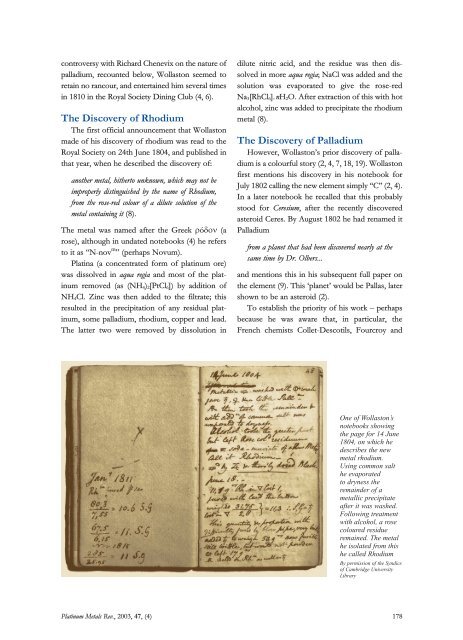Bicentenary of Four Platinum Group Metals - Platinum Metals Review
Bicentenary of Four Platinum Group Metals - Platinum Metals Review
Bicentenary of Four Platinum Group Metals - Platinum Metals Review
You also want an ePaper? Increase the reach of your titles
YUMPU automatically turns print PDFs into web optimized ePapers that Google loves.
controversy with Richard Chenevix on the nature <strong>of</strong><br />
palladium, recounted below, Wollaston seemed to<br />
retain no rancour, and entertained him several times<br />
in 1810 in the Royal Society Dining Club (4, 6).<br />
The Discovery <strong>of</strong> Rhodium<br />
The first <strong>of</strong>ficial announcement that Wollaston<br />
made <strong>of</strong> his discovery <strong>of</strong> rhodium was read to the<br />
Royal Society on 24th June 1804, and published in<br />
that year, when he described the discovery <strong>of</strong>:<br />
another metal, hitherto unknown, which may not be<br />
improperly distinguished by the name <strong>of</strong> Rhodium,<br />
from the rose-red colour <strong>of</strong> a dilute solution <strong>of</strong> the<br />
metal containing it (8).<br />
The metal was named after the Greek ródon (a<br />
rose), although in undated notebooks (4) he refers<br />
to it as “N-nov m ” (perhaps Novum).<br />
Platina (a concentrated form <strong>of</strong> platinum ore)<br />
was dissolved in aqua regia and most <strong>of</strong> the platinum<br />
removed (as (NH 4) 2[PtCl 6]) by addition <strong>of</strong><br />
NH 4Cl. Zinc was then added to the filtrate; this<br />
resulted in the precipitation <strong>of</strong> any residual platinum,<br />
some palladium, rhodium, copper and lead.<br />
The latter two were removed by dissolution in<br />
dilute nitric acid, and the residue was then dissolved<br />
in more aqua regia; NaCl was added and the<br />
solution was evaporated to give the rose-red<br />
Na 3[RhCl 6].nH 2O. After extraction <strong>of</strong> this with hot<br />
alcohol, zinc was added to precipitate the rhodium<br />
metal (8).<br />
The Discovery <strong>of</strong> Palladium<br />
However, Wollaston’s prior discovery <strong>of</strong> palladium<br />
is a colourful story (2, 4, 7, 18, 19). Wollaston<br />
first mentions his discovery in his notebook for<br />
July 1802 calling the new element simply ‘‘C’’ (2, 4).<br />
In a later notebook he recalled that this probably<br />
stood for Ceresium, after the recently discovered<br />
asteroid Ceres. By August 1802 he had renamed it<br />
Palladium<br />
from a planet that had been discovered nearly at the<br />
same time by Dr. Olbers...<br />
and mentions this in his subsequent full paper on<br />
the element (9). This ‘planet’ would be Pallas, later<br />
shown to be an asteroid (2).<br />
To establish the priority <strong>of</strong> his work – perhaps<br />
because he was aware that, in particular, the<br />
French chemists Collet-Descotils, <strong>Four</strong>croy and<br />
One <strong>of</strong> Wollaston’s<br />
notebooks showing<br />
the page for 14 June<br />
1804, on which he<br />
describes the new<br />
metal rhodium.<br />
Using common salt<br />
he evaporated<br />
to dryness the<br />
remainder <strong>of</strong> a<br />
metallic precipitate<br />
after it was washed.<br />
Following treatment<br />
with alcohol, a rose<br />
coloured residue<br />
remained. The metal<br />
he isolated from this<br />
he called Rhodium<br />
By permission <strong>of</strong> the Syndics<br />
<strong>of</strong> Cambridge University<br />
Library<br />
<strong>Platinum</strong> <strong>Metals</strong> Rev., 2003, 47, (4) 178
















